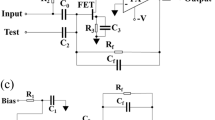Abstract
The results of the concentration method development for the data coming from the detector integrated circuits, intended for the experimental facilities MPD and BM@N, are presented. Charged particle detectors at these installations are characterized by a high granularity and accuracy of the detecting equipment. That results in a large data volume and the need to transfer processed data at a gigabit rate. Therefore, ASIC of the data concentrator requires both a high integration and use of specific structure as well as circuit and layout to provide an increased radiation tolerance. A specific feature of the ASIC is its ability to operate in the actual radiation background of the experiments estimated by up to 100 kRad in terms of immunity to heavy charged particles. In order to approbate the method and solutions on improvement of the radiation tolerance, the design results of a prototype 65 nm CMOS ASIC for read-out the signals from two SAMPA front-end chips cards are described. ASIC is intended for data receipt, concentration and subsequent transmission at a rate of 2.56 Gbit/s over micro-coaxial cables of 1 m length.




Similar content being viewed by others
REFERENCES
G. Cheremukhina, S. Movchan, S. Vereschagin, and S. Zaporozhets, “Front-end electronics development for TPC detector in the MPD/NICA project,” J. Instrum. 12, C06031 (2017).
S. Vereschagin, S. Movchan, and S. Zaporozhets, “Front-end electronics development for TPC/MPD detector of NICA project,” J. Instrum. 15, C09044 (2020).
E. Chatzikyriakou, K. Morgan, and C. Kees de Groot, “Total ionizing dose hardened and mitigation strategies in deep submicrometer CMOS and beyond,” IEEE Trans. Electron Devices 65, 808–819 (2018).
M. Krohn, B. Bentele, D. Christian, J. Cumalat, G. Deptuch, F. Fahim, J. Hoff, A. Shenai, and S. Wagner, “Radiation tolerance of 65 nm CMOS transistors,” J. Instrum. 10, C05009 (2015).
M. Bucher, A. Nikolaou, A. Papadopoulou, N. Makris, L. Chevas, G. Borghello, H. Koch, and F. Faccio, “Total ionizing dose effects on analog performance of 65 nm bulk CMOS with enclosed-gate and standard layout,” in International Conference on Microelectronic Test Structures (Austin, 2018).
P. Bonacini, R. Valerio, R. Avramidou, R. Ballabriga, F. Faccio, K. Kloukinas, and A. Marchioro, “Characterization of a commercial 65 nm CMOS technology for SLHC applications,” JINST 7, P01015 (2012).
Adolfsson, J. et al. (ALICE Collab.), “SAMPA Chip: The new 32 channels ASIC for the ALICE TPC and MCH Upgrades,” JINST 12, C04008 (2017).
A. Velure, and B. Sanches, SAMPA V3 Specifications rev. 0.1 (2017), https://indico.cern.ch/event/617831/attachments/1428015/2199874/SAMPA_V3_Specification.pdf.
A. Widmer and P. Franaszek, “A DC-balanced, partitioned-block, 8B/10B transmission code,” IBM J. Res. Dev. 27, 440–451 (1983).
S. Kulis, L. Jara Casas, D. Ceresa, S. Miryala, J. Christianses, R. Francisco, and D. Gnani, “Characterization of radiation effects in 65 nm digital circuits with the DRAD digital radiation test chip,” J. Instrum. 12, C02039–C02039 (2017).
R. Lacoe, “Improving integrated circuit performance through the application of hardness-by-design methodology,” IEEE Trans. Nucl. Sci. 55, 1903–1925 (2008).
D. Fleetwood, “Total ionizing dose effects in MOS and low-dose-rate-sensitive linear-bipolar devices,” IEEE Trans. Nucl. Sci. 60, 1706–1730 (2013).
C. Claeys, E. Simoen, “Physics and modeling of radiation effects in advanced CMOS technology nodes,” in Simulation of Semiconductor Processes and Devices (Springer, 2004), pp. 181–190.
Camplani A. S. Shojaii, H. Shrimali, A. Stabile, and V. Liberali, “CMOS IC radiation hardening by design,” Electron. Energ. 27, 251–258 (2014).
L. Seixas, O. Goncalez, R. Souza, S. Finco, Vaz R., G. da Silva, and S. Gimenez, “Improving MOSFETs’ TID tolerance through diamond layout style,” IEEE Trans. Device Mater. Reliab. 17, 593–595 (2017).
F. Faccio, S. Michelis, D. Cornale, A. Paccagnella, and S. Gerardin, “Radiation-induced short channel (RISCE) and narrow channel (RINCE) effects in 65 and 130 nm MOSFETs,” IEEE Trans. Nucl. Sci. 62, 2933–2940 (2015).
M. Menouni, M. Barbero, F. Bompard, S. Bonacini, D. Fougeron, R. Gaglione, A. Pozanov, P. Valerio, and A. Wang, “1-Grad total dose evaluation of 65 nm CMOS technology for the HL-LHC upgrades,” J. Instrum. 10, C05009 (2015).
M. Lee and H. Lee, “Dummy gate-assisted n-MOSFET layout for a radiation-tolerant integrated circuit,” IEEE Trans. Nucl. Sci. 60, 3084–3091 (2013).
V. Díez-Acereda, S. Khemchandani, del J. Pino, and S. Mateos-Angulo, “RHBD techniques to mitigate SEU and SET in CMOS frequency synthesizers,” Electronics 8, 690 (2019).
G. Maurice et al. (RD53 Collab.), The RD53A Integrated Circuit. CERN-RD53-PUB-17-001, Version 3 . 51 (2019).
Funding
This work was supported by the Russian Foundation for Basic Research (project no. 18-02-40093).
Author information
Authors and Affiliations
Corresponding authors
Rights and permissions
About this article
Cite this article
Atkin, E., Azarov, D., Normanov, D. et al. Development of Data Concentration Method and Its Implementation in a Radiation-Tolerant CMOS Application Specific Integrated Circuit. Phys. Part. Nuclei 52, 752–756 (2021). https://doi.org/10.1134/S1063779621040080
Received:
Revised:
Accepted:
Published:
Issue Date:
DOI: https://doi.org/10.1134/S1063779621040080




